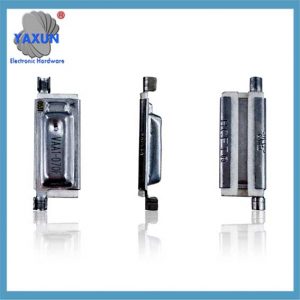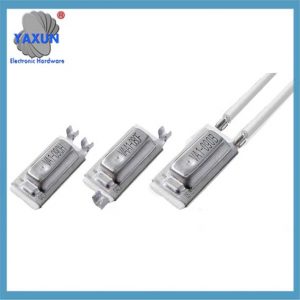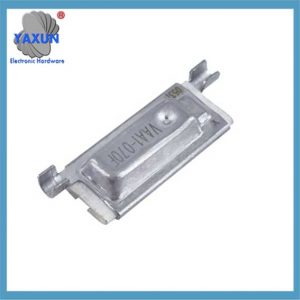Hitri termostat/toplotna zaščita z najvišjimi stopnjami stika med vsemi našimi krmilniki. Primerno za uporabo na 120/240 VAC obremenitve. Na voljo z različnimi bimetalnimi elementi za izboljšanje zmogljivosti. Izbira toplotne zaščite proti lezenju zahteva analizo specifikacij za drog in met, nastavljena temperatura, histereza, najvišji nazivni tok, nazivna največja AC napetost, nazivna največja enosmerna napetost, in zamenjaj življenje.
Pole-and-throw specifications
Single pole, en met (SPST) switches make or break the connection of a single conductor in a single branch circuit. They have two terminals and are commonly referred to as “single pole” switches.
Single pole, double throw (SPDT) switches make or break the connection of a single conductor with either of two other single conductors. Often called “three-way switches,” SPDT devices have three terminals and are used in pairs.
Double pole, en met (Dpst) switches make or break the connection of two circuit conductors in a single branch circuit and usually have four terminals.
Double pole, double throw (DPDT) switches make or break the connection of two conductors in two separate circuits. Most DPDT switches have six terminals and are available in either momentary or maintained contact versions.
Creep-Action Thermal Protectors with more than two poles are designed to split loads into separate circuits.
Creep-Action Thermal Protectors Set-point Temperature
Creep-Action Thermal Protectors Specification Guide Thermal switches and thermal protectors have a set point temperature that is either fixed or field adjustable. Nastavljena točka je nazivna temperatura, pri kateri se stanje naprave spremeni zaradi premikanja električnih kontaktov.. Naprave s fiksno točko so ocenjene na dano temperaturo, medtem ko imajo terensko nastavljive naprave temperaturno območje, v katerem je mogoče nastaviti nastavljeno točko.
Creep-Action Thermal Protectors Hysteresis
Histereza, imenovana tudi temperaturna razlika, je končno temperaturno območje, v katerem poteka preklop. Zasnovan je tako, da preprečuje nenehno spreminjanje vezja med stanji. Histereza od 0.5 C se običajno aktivira 0.5 stopinj nad nastavljeno temperaturo in ne spremeni stanja znova, dokler temperatura ne pade na 0,5 C pod nastavljeno temperaturo.
Ambient Temperature: The normal or typical temperature of the environment surrounding the device.
Automatic Reset: A thermostat that automatically resets to its pre-trip contact configuration at a factory preset temperature.
Bimetalni: Two metals with different rates of expansion molecularly bonded together to form a blade or disc for a thermostat.
Creep Action Thermostat: A thermostat with a bimetal blade that slowly makes the contacts or slowly breaks the contacts.
Current Derating: Term used to describe a predictable condition where increased current applied to a thermostat causes the device to open at a temperature below its set point. This condition is present only in Normally Closed bimetal thermostats that are both current and temperature sensitive.
Functioning Temperature: (TF of Tf) In reference to a thermal cutoff, as defined by IEC Standards, the temperature at which a Thermal Cutoff opens a circuit under a no load condition. The IEC tolerance is +0 C, -10 C.
Holding Temperature: (TH or Th) In reference to a thermal cutoff, the maximum temperature that a Thermal Cutoff can maintain Rated Current for a period of 168 hours with functioning.
Maximum Temperature: (TM or Tm) In reference to a thermal cutoff, the maximum temperature to which the device can be subjected for a period of ten minutes without resuming conductivity once it has opened.
Minimum Differential: (also known as deadband) The minimum number of degrees between the actual open and actual close temperatures.
Motor Protector: A thermal protector that is sensitive to both increases in current and increases in temperature.
Običajno zaprto (N.C.): Contacts open on temperature rise.
Običajno odprto (N.O.): Contacts close on temperature rise.
One Shot: A device that, once activated at its preset temperature, cannot be reset. Available only in Normally Closed contact configuration.
Nazivni tok: The maximum allowable current that a device can carry.
Nazivna napetost: The maximum voltage that should be applied to a device.
Self-Hold Protector: A device that, upon opening, will not reset until power is removed from its circuit regardless of ambient temperature. Available only in Normally Closed contact configuration.
Snap Action Thermostat: A thermostat with a Bimetal element that snaps to close the contacts when the activation condition is experienced. This construction permits the clean break of loads.
Toplotni izklop: A thermal cutoff is an electrical safety device that interrupts electric current when heated to a specific temperature.
Thermal Cutoff Fuse: A device that melts its internal element to open a circuit in an over-temperature condition. Also known as a thermal fuse, thermal protector fuse or thermal switch.
Termični zaščitnik: A Thermal Protector is a protective device built into a motor that provides over-current or over-temperature protection that disconnects power to the ballast if internal temperatures rise above the trip point. This protects motors from overheating. Types of switches include automatic rest, manual reset and resistance temperature detectors.
Strpnost: The allowable range above and below a nominal temperature.
 English
English العربية
العربية Български
Български 粤语
粤语 中文(简体)
中文(简体) 中文(漢字)
中文(漢字) Nederlands
Nederlands Suomi
Suomi Français
Français Deutsch
Deutsch Ελληνικά
Ελληνικά Magyar
Magyar Italiano
Italiano 日本語
日本語 한국어
한국어 Polski
Polski Português
Português Română
Română Русский
Русский Slovenščina
Slovenščina Español
Español Svenska
Svenska ภาษาไทย
ภาษาไทย Türkçe
Türkçe Tiếng Việt
Tiếng Việt



